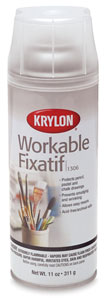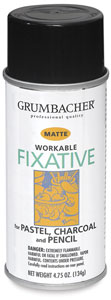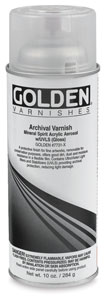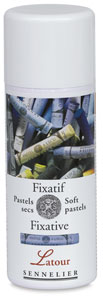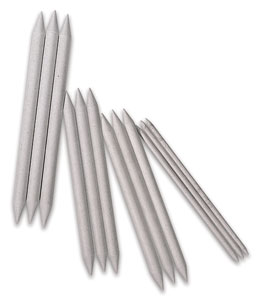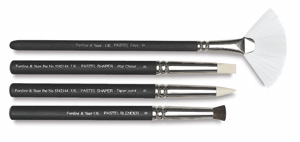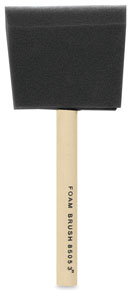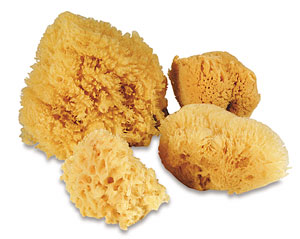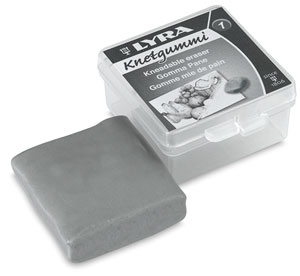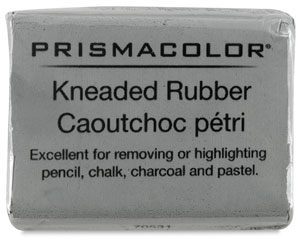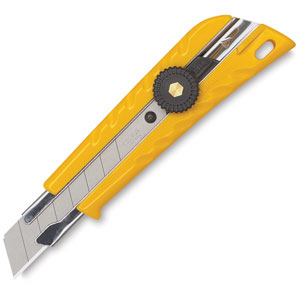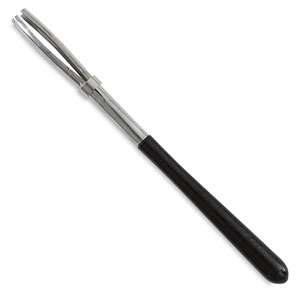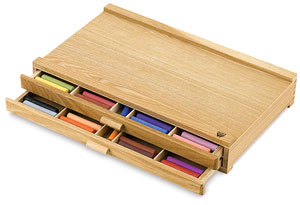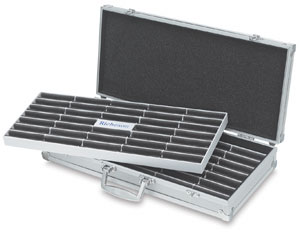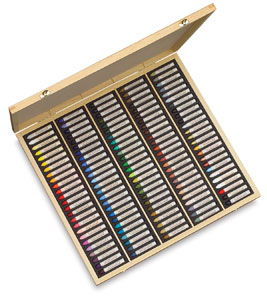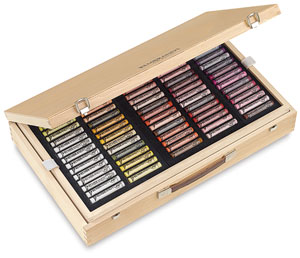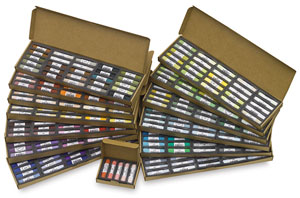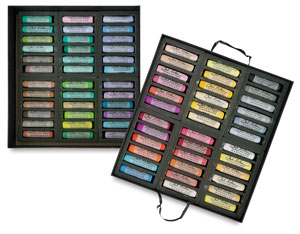Accessories for Pastels
There are various accessories for pastels that can certainly be handy to have around, but most of them aren’t essential to making art with pastels. The coolest thing about pastels is their ease of use—with just a piece of paper, some pastels, and your fingers, you can create a complete work of pastel art! If you're just starting out, keep things simple. As you become more accustomed to working with pastels, you can think about which of the accessories below might enhance your pastel art-making experience.
Let's take a look at the following accessories for pastels to give you an idea of what you might need: Fixative, Blenders, Erasers, Sharpeners, Pastel Holders, Pastel Boxes, and Safety.
Pastel Fixative
Pastel particles can be easily smudged, wiped, or knocked off the surface - which you may do on purpose at times, but there are other times both during and after the creation of your pastel art when you want those pastel particles to stay firmly in place. This can especially be a problem with soft pastels. So if you've ever wondered how to keep soft pastels from smudging, the answer is pastel fixatives!
Fixatives are designed to fix the particles in place so that they won't dislodge during and after creation. There are two main types of fixative: workable and final fixatives. We'll take a closer look at these two different types of fixatives below, followed by a discussion on whether you even should fix your pastel art.
Workable Fixatives
Workable fixatives are handy for use between layers, so that colors will stay in place when you're layering or blending. Workable fixatives are also useful if you have to leave a work unfinished for a while, and you want to make sure it's protected in the meantime. Workable fixatives aren't essential; they're more a case of personal preference. You can still layer and blend without them, and if you want to protect an unfinished painting without using a fixative, you can tape some glassine or tracing paper over the artwork, because they are nonabsorbent sheets that won't attract or disurb the pastels.
I've provided links below to the relevant products so that you can easily find them on Blick Art Materials, my favorite online art supplier. I'm a member of Blick's affiliate program, which means if you make a purchase after clicking on one of these links, I'll receive a small commission (at no extra cost to you). Your purchase helps support this site and keeps it free of ads. Click here for more info.
Final Fixatives
Final fixatives are intended for finished pastel paintings, so they are not meant for pastel artwork you want to continue to work on. A final fixative will protect the pastel artwork from smudging, air pollution and ultra violent light. Final fixative can be purchased for use with a diffuser, but I prefer the more convenient spray can.
To fix or not to fix?
This question will elicit a variety of passionate responses from pastel artists and enthusiasts, because everyone has their own personal preference.
The downsides of using fixatives are that they can:
Some artists like the effects that fixatives can have on their artwork, and they're mentally prepared for the types of color changes that can result from using a fixative. Other artists avoid fixatives entirely and feel quite strongly about it. Whether or not you want to use a fixative is up to you and your personal preference. If you're new to pastels, you'll never know how you feel about fixatives unless you try them.
Before using any fixative I recommend testing it first to see how it might affect your colors. You can rub some pastels of various colors onto spare pastel paper, give it a spray according to the instructions on the can, and see what you think of the results.
When possible, I usually prefer to protect my pastel artworks by framing them behind glass, but I've experimented with all the fixatives listed above at some point or other. When I do use fixatives on finished pastel works, I use Golden Archival Spray Varnish, which, in addition to being one of the best fixatives for pastels, can also be used on other media.
Some fixatives are meant only for water-based media, which means you can't use them with oil pastels. Just make sure you read the product description before buying or buy something made specifically for oil pastels, like D'Artigny Oil Pastel Fixative by Sennelier.
Learning how to blend pastels will take your pastel art to the next level! There are a wide range of pastel blending tools that you can use to blend and manipulate pastels:
Stumps or tortillons are traditional blending tools for pastels made from tightly-rolled paper that is pointy at one end. When the end becomes dirty, you can just peel away a layer of paper to reveal a fresh point.
You can also buy brushes designed that are specifically for blending pastels. They come in a range of shapes made from natural or synthetic fibers. Brushes can also be used to remove pastel by gently flicking it off the surface.
Sponges are also commonly used for blending pastels and can be purchased mounted onto a wooden handle for extra control. You can also save some money by using basic cotton swabs or balls for blending.
Many pastel artists enjoy using their bare fingers with pastels and don’t give it a second thought, while many other artists have concerns about the pastel particles absorbing into their skin, and worry about the cumulative effects of this that may build up over time. If you’re concerned about your fingers, then the latex finger cots linked to below are a good option to keep your fingers clean and protected (so long as you don’t have a latex allergy).
The Recommended Products below are there to help you browse for art supplies, and if you make a purchase I get a small commission that supports this site and keeps it FREE! Thanks in advance.
Your best pastel eraser option is a kneadable eraser which can lift off color (also referred to as a “putty eraser”). These erasers can also be shaped to a fine point which allows you to remove tiny sections. Pastel particles can also be flicked off the support with a stiff brush. Most commercially available erasers won't work with pastels, and oil pastels can't be removed with an eraser at all. Avoid latex and plastic erasers because they'll just rub the pastel particles deeper into the tooth of the surface.
Some homemade pastel tools can be surprising. One artists' trick is to take some fresh bread and roll it into a soft ball! Apparently it's quite effective at extracting pastel particles.
The best accessory for sharpening pastel sticks is a sandpaper block. It's simply a pad of sandpaper sheets attached to a small piece of wood. You scrape the pastels (and pencils too) along the rough surface to make sharp edges that are perfect for detail work.
When it comes to pastel pencils, you can use a regular sharpener, though to avoid the risk of breaking the pastel cylinder I recommend using a sandpaper block or a sharp knife. Having a knife in your studio is also handy when you need to cut paper or when using scraping techniques on your artwork.
Pastel holders, also called graphite or charcoal holders, are convenient when you want to be able to use a worn-down pastel stick and maintain control. When you've spent a fortune on artists' quality pastels you don't want to waste a single pastel particle!
Pastels holders are also used by artists who don't want to get their hands dirty. Pastels can be really messy, so I also keep some wet wipes nearby. Holders can also help artists who find it easier to grip and control a holder rather than a slim pastel stick.
Pastels are fragile and delicate and need to be protected so they don't break. You can buy wooden, metal, plastic and cardboard boxes, and all feature snug slots for your pastels so they don't move around and mix with each other. Boxes also help you keep your pastels organized and in order.
When you purchase a box set of pastels, it usually comes with suitable storage box or at least a tray of some kind, depending on the quality of the pastels, so you'll really only need to buy a box or cabinet for your pastels if you buy them individually or if you want to change to a different storage format.
The Recommended Products below are there to help you browse for art supplies, and if you make a purchase I get a small commission that supports this site and keeps it FREE! Thanks in advance.
Safety
I briefly addressed safety on the introductory pastels page, but I thought it was worth mentioning again. Soft pastels release airborne pigment dust which can be easily inhaled. Most manufactuers now produce non-toxic pastels, but it's always wise to take precautions. I try to use pastels outside or in a well-ventilated room. There are accessories for pastels that can help—for instance, some artists wear face masks or respirators. My husband and I recently splurged on an air purifier which helps keep my studio dust free and also relieves his allergies.
You can check out more art supplies for pastels and other media via the guide to buying art supplies.


